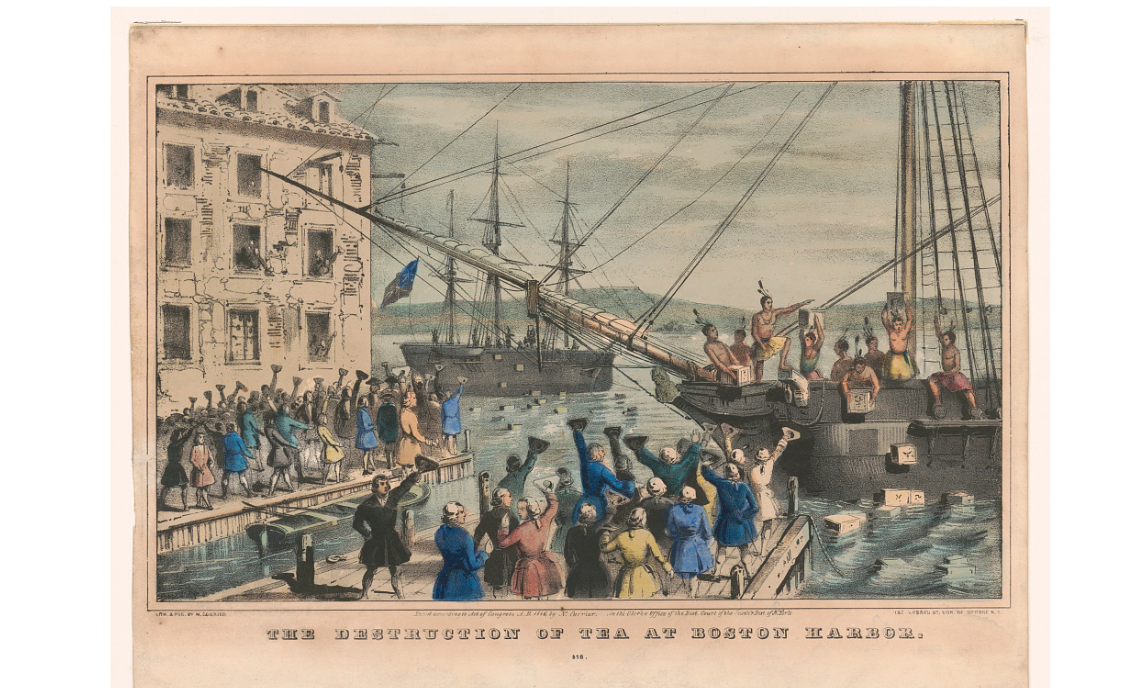The American Revolution and Tariffs on Tea
In the 1760s and 1770s, British taxes on the American colonies, including the infamous tea tax, sparked outrage and contributed to the American Revolution. The Tea Act of 1773 wasn’t a new tax but granted the British East India Company a monopoly on tea sales, undercutting colonial merchants and reinforcing earlier taxes from the Townshend Acts (1767). This became a symbol of “taxation without representation,” as colonists had no voice in British Parliament.

Suggested Graphic: An illustration of colonists dumping tea into Boston Harbor during the Boston Tea Party, 1773. (Source: Public domain image or generate via AI tool with prompt: “Historical scene of Boston Tea Party, colonists throwing tea crates into harbor at night”)
The Boston Tea Party, where colonists dumped tea into Boston Harbor, protested both the tea tax and British control over trade. The Navigation Acts further restricted colonial trade, costing the colonies an estimated 2.3% of their income in 1773, with southern colonies like Virginia and Maryland losing up to 2.5% due to limited tobacco exports (NBER study). These grievances fueled the push for independence.
Current U.S. Tariffs on Imports
In 2025, the U.S. has imposed tariffs on imports, including a 10% baseline tariff on most countries and up to 145% on goods from China, effective April 2025 (White House). Unlike colonial times, these tariffs are a sovereign policy aimed at protecting domestic industries, enhancing national security, and gaining trade leverage.
Key Reasons for Modern Tariffs
- Protecting Domestic Industries: Tariffs shield U.S. manufacturing from foreign competition, especially from China, to reduce trade deficits ($1.2 trillion in 2024) (U.S. Census Bureau).
- National Security: Tariffs on steel, aluminum, auto parts (25%), and copper (50%) are justified under Section 232 to secure critical supply chains.
- Negotiation Leverage: Tariffs pressure trading partners for better terms, as seen in the 2025 tariff truce with China (Reuters).
- Revenue Generation: Tariffs generated $77 billion in 2024, though they’re a small fraction of federal revenue (1.57%) (U.S. Customs Service).
Impact on Tea and Other Imports
The U.S. imports $550 million in tea annually, with tariffs hitting suppliers like Japan, India, and China (145%). With only 0.02% of tea produced domestically, these tariffs raise consumer prices (Tea Association of the USA). Unlike colonial tea taxes, modern tariffs are strategic, not symbolic.
Why the Apparent Contradiction?
The colonial revolt was about rejecting British control, not tariffs themselves. Post-independence, the U.S. used tariffs for revenue and protectionism, starting with the Tariff Act of 1789. Today’s tariffs address trade imbalances, security, and economic nationalism, but risk higher prices and trade wars, as seen with China’s retaliatory tariffs (Bloomberg). The Smoot-Hawley Tariff of 1930 shows the risks of protectionism.
In short, the tea tax was a spark for revolution over self-determination, while modern tariffs are a tool for economic strategy. Both highlight tariffs’ power to shape economies and spark debate.
Sources
- History.com: Tea Act
- History.com: Townshend Acts
- History.com: Boston Tea Party
- Britannica: Navigation Acts
- NBER: Colonial Trade Restrictions
- U.S. Census Bureau: Trade Balance
- U.S. Department of Commerce: Section 232
- Reuters: Tariff Negotiations
- U.S. Customs Service: Tariff Revenue
- Tea Association of the USA
- Bloomberg: China’s Retaliatory Tariffs
- History.com: Smoot-Hawley Tariff
- Library of Congress: Tariff Act of 1789